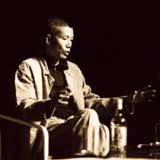| |
|
 |
 |
 |
 |
In conversation
with Cai Guo-Qiang, September 2002.
Extract
James Putnam: Do you seriously think your works will be seen by aliens from another planet or is it more of an artistic concept
Cai Guo-Qiang: Both
JP: So you obviously believe in extra-terrestrials?
CGQ: Yes - I'm also an extra-terrestrial myself!
JP: Your interest in the birth of the universe - the so-called 'big bang theory' - does this have a bearing on your fascination with the properties of gunpowder- an essentially destructive force that you turn into a creative force?
CGQ: Yes and also the properties of speed and light that comes with a gunpowder explosion and this time and space chaos that happens simultaneously and this blink.
JP: Are any of your thoughts based around Buddhist or Taoist theories about the creation, the idea of emptiness - not emptiness in the limited western sense but emptiness as a space for incredible possibilities
CGQ: Yes very much so and especially after arriving in Japan and discovering about the western theories of birth of the universe and astrophysics - that was a really big discovery and surprise because it had so much in common with Taoist philosophy. The expansion of the universe and the idea of the black hole, contracting and expanding and these different opposite forces working at the same time with each other
JP: With the huge amount of work that it takes to stage these projects that are over with relatively quickly in some cases - do you feel that the spectator is part of the work. Do you think having a large audience that carry it as a memory in their minds is almost more important than having a lasting monumental work of art for the event?
CGQ: One thing, the scale of the work has something to do with Chinese heritage, like the Great Wall of China, its huge. Starting out with the extra-terrestrial series I wasn't concerned with the audience, it didn't really matter that human beings could see them, the point of focus is really about the other perspective, coming from outside. Later on after being invited by museums and different organizations, government backed institutions, I realize that the funding is really coming from the peoples' tax money so you want to be responsible and include people in it as spectators. So everyone can be an extra-terrestrial, in that everyone is invited to see, to be included
JP: The fact that a lot of the works are ephemeral - does this give you a particular insight into the whole idea of time?
CGQ: The reality of life, what life is about, your memory, your dreams, your desires - these have something that you can't really put your finger on, can't really have a firm grasp on, but that's so much part of you, also the fact that we have evolved through the ages and this memory, this vast history that's embedded in us, this type of thing as well - so its not so physical.
JP: I'd like you to say a little bit about your fascination for the mushroom cloud, the A bomb explosion, because for many people it's more or less a kind of symbol of human destruction - the apocalypse rather than something that's a very beautiful aesthetic thing as an image- what's your vision of the mushroom cloud image
CGQ: This series of works really started after I arrived in the United States being there you can't help to be influenced by it, its social and political backgrounds and this arrives out of impressions of living there. I feel that the mushroom cloud is the strongest emblem that humans made for the 20th century. The 20th century can be said to be an American century - the work of the land artists for example relate to this. The mushroom cloud is one of the most tragic, beautiful and powerful image and behind this there's also great contradiction and pain that comes with it.
JP: As one final and rather predictable question, how much has the events of September 11 affected your work in terms of getting permission for projects - If the projects were post that time would they have been more difficult to realize?
CGQ: Of course - for example I actually had a project to create a mushroom cloud on the top of one of the twin towers. One of the important changes is my love for New York - this attachment has strengthened, before I felt like a guest being there, but now my destiny is linked with its destiny. Doing the Rainbow project at the invitation of MoMA, I really wanted to do something for the city of New York and I came up with this idea of the rainbow, it's like a rainbow after the storm, after the clouds, because at that time I wanted to do something for the city that was beautiful that would uplift, it may be idealistic but it was something that the city needed so much.
|
|
 |
 |
Cai Guo-Qiang at the British Museum
|

|
 |
 |
|
|
|